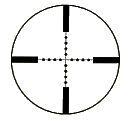


Makes complicated Mil-Dot calculations as easy as 1-2-3 shoot !!
Use what the professionals use.
Awarded U.S. Army Contract # DAAE30-01-M-1461
Currently in use, in Afghanistan
|
Align Target Size with number of mils it takes to cover the target. Determine correct bullet drop from known bullet drop data for your
load. Mildot Mastertm lets you know both hold-over in mils and how
much minute of angle (MOA) so that you know how many clicks to turn
your scope. Compensate for the range by making adjustments to your elevation
knob or by holding over the correct amount of mils. |
Situation :
The Mil-Dot reticle is in increasingly widespread
use among long-range rifle shooters as a means of estimating the range to
the target. This estimation is
critical in order to correct for the varying degree of projectile drop (and/or
wind drift) at different ranges and thereby enable the shooter to hit the
target.
With training and familiarization, an experienced marksman can accurately
estimate range to target by using this type of reticle and by making the
appropriate calculations.
Originally fitted to telescopic sights designed for military (and later police)
use, the mil-dot reticle has seen growing acceptance in the civilian sector
among target shooters and hunters.
Principle:
By using a set of fixed references within the scope, the shooter can compare
the size of the target, a portion of the target, or a nearby reference target
to a series of precisely sized dots and spacing. By estimating the size of
the target or nearby reference and noting the number of mils that equal the
size
of the target, the shooter can determine the range to the target by applying
a formula (size of target in yards multiplied by 1000, divided by size of
target in
mils, equals range to target in yards), usually done by employing the help
of a conventional hand held electronic calculator.
|
Problems:
|
|
The necessary calculations are somewhat complex and
depend upon the shooter's ability to remember and correctly apply the
formula.
|
|
The size of the target is more often than not mentally
estimated in inches, necessitating an additional calculation to convert
the target size into a decimal equivalent of yards. ie: 18" shoulder
width. If the range is to be calculated in meters, an additional conversion
from yards to meters in necessary.
|
|
Even after the shooter has gone through the range
calculation procedure, the amount of bullet drop (or wind\drift) applicable
to that range must now be applied to the sight picture to enable a hit
on the target. Either the scope must be adjusted or the sighting point
"held over", which necessitates a second series of calculations
to translate the needed amount of correction into a scope adjustment
or hold-over figure for that range and load.
|
|
Aside from the possibility of errors occurring during
these calculations, the time involved in such calculations can prove
problematic in certain scenarios, such as military or police counter-sniping
operations, timed competitive target-shooting events, or hunting situations.
|
|
Solution:
Eliminate the need for multiple data steps and simplify the calculations by the use of an analog calculator designed solely for this purpose. The Mildot Mastertm is an analog calculator designed along the principle of a slide rule, utilizing logarithmic and inverse logarithmic scales developed specifically for performing the following operations: |
|
Rapid and simple calculation of range to target, based
on a measurement of the target with a mil-dot reticle, by aligning the
estimated target size directly opposite the mil-dot measurement, and
then reading the range at an index mark.
|
|
Rapid and simple calculation of the amount of sight
correction necessary to compensate for bullet drop and/or wind drift
for a given range, enabling the shooter to determine either the equivalent
scope sight adjustment (minute of angle, or MOA) or the equivalent hold-over
(mils), by reading equivalents in both MOA and mils directly opposite
the bullet drop/wind drift figure.
|
|
Additionally, angle of fire for uphill or downhill
shots can be accurately measured, and the up/down compensation can be
closely calculated to reduce the errors such shots can induce.
|
|
Advantages:
|
|
No conversion of estimated target size from inches
into decimal equivalent of yards is necessary.
|
|
No entry of data through a keypad is necessary, devise
is purely analog and only requires the alignment of figures on scales.
|
|
No memorization of formulas
|
|
No separate data sheet is necessary, as reverse side
is designed to accept data decals or user produced data strips.
|
|
Speed of calculations is dramatically increased
|
|
Mildot Mastertm is made of only two parts and uses
no electrical parts. Extremely reliable under adverse conditions.
|
|
Mildot Mastertm can measure the angle of a shot( up
to 60 degrees above or below the horizon), and can be used to correct
for the effects of uphill/downhill shooting.
|
